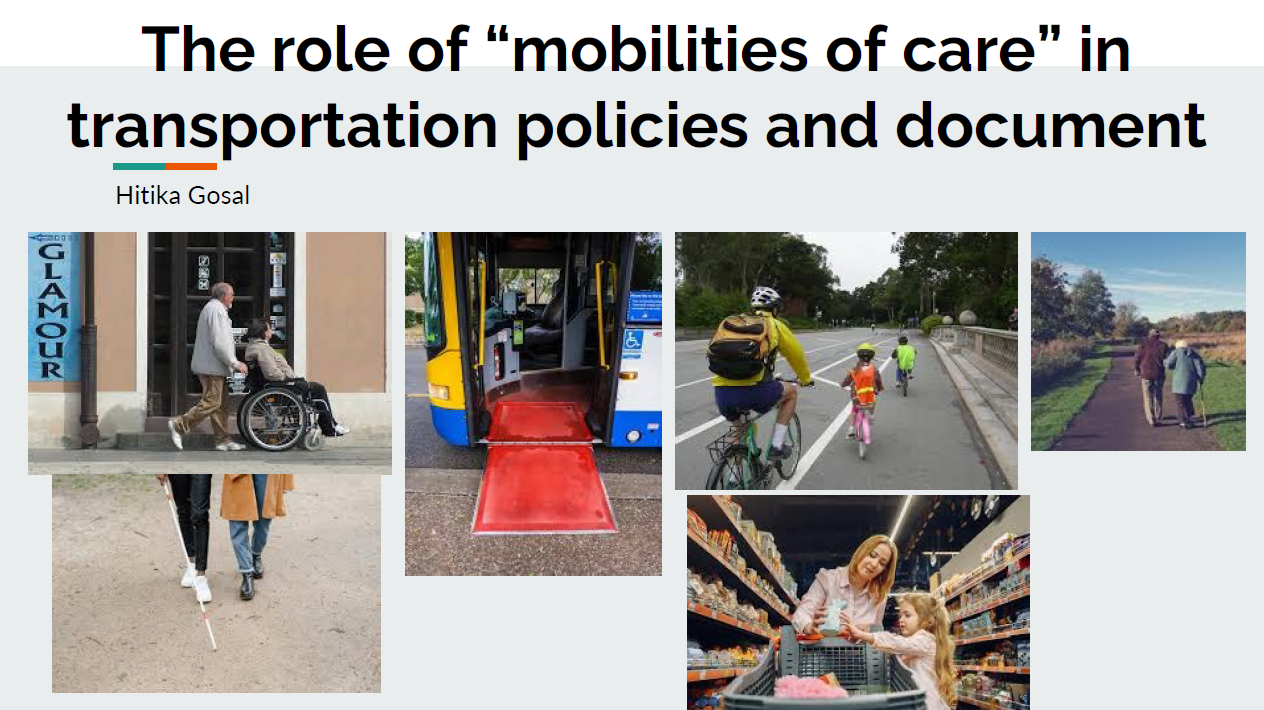Investigation of the role of ‘mobilities of care’ in city transportation planning and practice.
Main Article Content
Abstract
Is city transportation design a two-way street? City designs shape how residents interact with the built environment. In the transportation space, designs translate into decisions such as catching buses to reach classes, using rideshare services to commute to work, or cycling to social gatherings. Built environments less supportive of active travel may result in parents driving their children to events, and school buses predominantly serving the neighborhood's school-going children. Therefore, built environments undoubtedly impact the daily routines of city residents. However, how do the needs of city residents influence city planning? The term "mobilities of care" recently coined by Ines Sanchez de Madariaga encompasses the daily travel associated with caregiving. This includes non-paid care provided to other individuals, such as picking up and dropping off children to/from school or helping a friend with grocery. Mobilities of care are care-related, and integral to our daily lives, as care is a fundamental component of human existence. Yet, a question remains: are care-related trips a consideration in cities’ transportation plans? And are caregiver needs sufficiently considered?
This project aims to undertake a policy scan of how cities across Canada address the mobilities of care in their policy and planning activities. In addition to answering this question via a policy scan, it is imperative to explore what mobilities of care entail, identify who is affected by mobilities of care, and discuss how cities can be investigated regarding where and how cities may address mobilities of care in their policy and practice.
Article Details

This work is licensed under a Creative Commons Attribution-NonCommercial-NoDerivatives 4.0 International License.
References
Minute city: Urban mobility solution to environment? (2023, November 13). Intertraffic. http://www.intertraffic.com/news/15-minute-city-urban-mobility-solution-to-environment
Abdullah, M., Dias, C., Muley, D., & Shahin, Md. (2020). Exploring the impacts of COVID-19 on travel behavior and mode preferences. Transportation Research Interdisciplinary Perspectives, 8, 100255. https://doi.org/10.1016/j.trip.2020.100255
City of Vancouver. (2012, October 31). Transportation 2040. https://vancouver.ca/files/cov/Transportation_2040_Plan_as_adopted_by_Council.pdf
De Madariaga, I. S., & Zucchini, E. (2019). Measuring Mobilities of Care, a Challenge for Transport Agendas. 145–173. https://doi.org/10.1007/978-3-030-05042-9_7
Gongadze, S., & Maassen, A. (2023, January 25). Paris’ Vision for a ‘15-Minute City’ Sparks a Global Movement. World Resources Institute. https://www.wri.org/insights/paris-15-minute-city
Jamstalldhet, S. (2014, June 9). Sustainable Gender Equality - a film about gender mainstreaming in practice [Video]. YouTube. https://www.youtube.com/watch?v=udSjBbGwJEg&t=9s
Li, D., & Guo, X. (2023). The effect of the time parents spend with children on children’s well-being. Frontiers in Psychology, 14. https://www.frontiersin.org/articles/10.3389/fpsyg.2023.1096128
Ng, W.-S., & Acker, A. (2018). Understanding Urban Travel Behaviour by Gender for Efficient and Equitable Transport Policies (International Transport Forum Discussion Papers 2018/01; International Transport Forum Discussion Papers, Vol. 2018/01). https://doi.org/10.1787/eaf64f94-en
Ravensbergen, L., Fournier, J., & El-Geneidy, A. (2022). Exploratory Analysis of Mobility of Care in Montreal, Canada. Sage Journals https://doi.org/10.1177/03611981221105
Sauer, E. (2022, March 9). The Gender Gap in Caregiving and Why Women Carry It. UMKC Women’s Center. https://info.umkc.edu/womenc/2022/03/09/the-gender-gap-in-caregiving-and-why-women-carry-it/
Semanjski, I. C. (2023). Transport planning and big data. In Smart Urban Mobility (pp. 171–204). Elsevier. https://doi.org/10.1016/B978-0-12-820717-8.00001-4
Statistics Canada. (2019, April 17). Population estimates, July 1, by census metropolitan area and census agglomeration, 2016 boundaries. https://www150.statcan.gc.ca/t1/tbl1/en/tv.action?pid=1710013501
Statistics Canada. (2022, November 30). Has the COVID-19 pandemic changed commuting patterns for good? https://www150.statcan.gc.ca/n1/daily-quotidien/221130/dq221130c-eng.htm
Thornton, L. E., Schroers, R.-D., Lamb, K. E., Daniel, M., Ball, K., Chaix, B., Kestens, Y., Best, K., Oostenbach, L., & Coffee, N. T. (2022). Operationalising the 20-minute neighbourhood. International Journal of Behavioral Nutrition and Physical Activity, 19(1), 15. https://doi.org/10.1186/s12966-021-01243-3
TransLink. (2019, October 10). 2017 Trip Diary. Tableau Public. https://public.tableau.com/app/profile/translink/viz/Trip_Diary_2017/TripDiary2017
TransLink. (n.d.). Accessing public transit. https://www.translink.ca/rider-guide/transit-accessibility/accessing-public-transit#travelling-with-an-attendant
Willis, R. (2012, January 18). Family-friendly transit. TransLink. https://buzzer.translink.ca/2012/01/family-friendly-transit/

